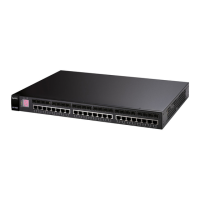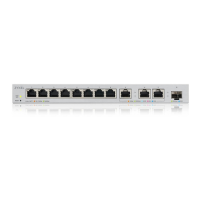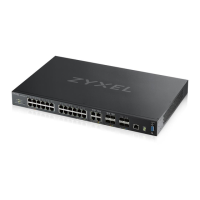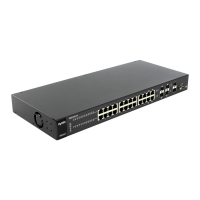Chapter 45 Access Control
XGS2210 Series User’s Guide
438
45.3.1 Configuring SNMP Trap Group
From the SNMP screen, click Trap Group to view the screen as shown. Use the Trap Group screen to
specify the types of SNMP traps that should be sent to each SNMP manager.
Figure 346 Management > Access Control > SNMP > Trap Group
The following table describes the labels in this screen.
Trap Community Enter the Trap Community string, which is the password sent with each trap to the SNMP
manager.
The Trap Community string is only used by SNMP managers using SNMP version 2c or lower.
Trap Destination Use this section to configure where to send SNMP traps from the Switch.
Version Specify the version of the SNMP trap messages.
IP Enter the IP addresses of up to four managers to send your SNMP traps to.
Port Enter the port number upon which the manager listens for SNMP traps.
Username Enter the username to be sent to the SNMP manager along with the SNMP v3 trap.
This username must match an existing account on the Switch (configured in Management >
Access Control > Logins screen).
Apply Click Apply to save your changes to the Switch’s run-time memory. The Switch loses these
changes if it is turned off or loses power, so use the Save link on the top navigation panel to
save your changes to the non-volatile memory when you are done configuring.
Cancel Click Cancel to begin configuring this screen afresh.
Table 197 Management > Access Control > SNMP (continued)
LABEL DESCRIPTION
Table 198 Management > Access Control > SNMP > Trap Group
LABEL DESCRIPTION
Trap Destination IP Select one of your configured trap destination IP addresses. These are the IP addresses of the
SNMP managers. You must first configure a trap destination IP address in the SNMP Setting
screen.
Use the rest of the screen to select which traps the Switch sends to that SNMP manager.
Type Select the categories of SNMP traps that the Switch is to send to the SNMP manager.
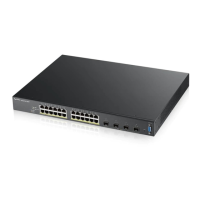
